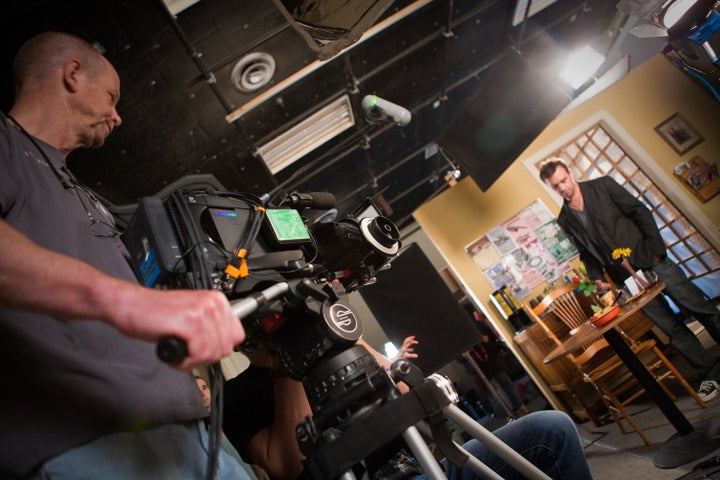
"We do this with two turntables, one mic and that's it," Madrid rapper El Meswy defiantly explains in my film Let Fury Have the Hour. "There's no intimidating gallery or museum threshold to have to cross," street artist Shepard Fairey adds. "There are alternatives: making stencils, making flyers." The basic tools of the artists, thinkers, and activists featured throughout my film serve to uplift a worldview that speaks to the human condition, part of a natural process to make art/work that communicates with people on a visceral level, fostering a deeper human connection. "This is not popular culture that is produced by some company to be sold and bought," historian Stanislao Pugliese stresses. "But true popular culture that starts in the streets."
Let Fury Have the Hour is a social history told not through war and conquest but through street art, literature, music, film, science, labor, public service or what I call creative-response. Creative-response is a way of interacting with the world around us rooted in the understanding that our problems are also our assets, our obstacles are also our opportunities. The resonant power of creative-response lies in the reality that the intuition of artists -- and those who ask "why not?" -- often precedes the comfortable, unchallenged "facts" of politics. As an enduring movement that is resolutely for, not against, creative-response grew even bolder under the dark cloud of Ronald Reagan and Margaret Thatcher, two leaders who rose to power in the 1980s speaking to the other side of people's emotion: not their aspiration, but their fear; not their need to come together, but their desire to pull apart. They convinced millions there was no alternative. They were decidedly against: against the gains of the New Deal, against the strides of the Great Society, against the egalitarian nature of the Social Democratic state. Thatcher summed it all up: "society doesn't exist." It was all just a great con trick that now has come to dominate and paralyze the present: society, compassion and citizenship swapped out for individualism, cynicism and consumerism.
Now, democracy is besieged, not ascendant. The current political movements and their leaders seem unable to grasp the enormity of the global challenges that stare out at us to the vanishing point. The international economic collapse remains just a precursor to the real havoc underway around the world. With America seemingly always trapped in a tug-of-war between cultural clashes and dystopian debates, we linger oblivious to the fact that there is a remarkable geopolitical shift unfolding that requires creative response, not reactionary rancorousness that stir violent energies.
What do we do when we face such overwhelming absurdity? This is just one of questions I ask in my film, turning to creative-response to search less for an answer but instead for a good idea that leads us to take active participation in the world around us. Often the genesis for creative response is a sincere attempt to begin a dialogue where once there wasn't one, a discussion leading to a re-imagining of the kind of world we all want to live in; a world where we are all masters of our own destiny, not instruments used by autocrats in the pursuit of power. It's for this reason that creative-response advances our most basic right: freedom of expression. Rapper Chuck D's performance in Let Fury Have the Hour echoes with this sensibility: "Our freedom of speech is our freedom from death." With this as the foundation, all those featured in my film cultivate a visionary approach propelled by creative-response, working within a timeless tradition that keeps alive our sensitivity to human nature and our ability to adapt to the shifting concerns of history. This is the Free Space, the realm where all creative-response merges to establish a dynamic counterpoint to the bad ideologies that seek to push us backward.
Within the Free Space, creative-response embraces the odd idea, the idiosyncratic thought, and the impractical strategy, twisting and bending our narrow ideas of what seems impossible into the possible. If we look back throughout the history of creative-response and the Free Space, whether it's the invention of the city or the printing press, the most important ideas have been things that connect us and bring us together. "One of the things that art does is it creates metaphor and it creates other avenues for the brain," playwright Eve Ensler explains in my film. "It gets into emotional reality. It gets into sympathy or empathy or compassion for characters." It's compassion that is the essential component of creative-response and the main ingredient of a democratic society. It's what sustains interconnection and interdependence, strengthening the Free Space as the place where our shared common humanity is revealed as the most compelling part of being alive. Ultimately, the Free Space is bursting with the awareness that we are all born citizens of the world: announcing it even in the worst of times, affirming it through our being, and asserting it through our creative-response. The choice to act or remain indifferent will determine whether or not we become agents of history and curators of an evolving planet.
As Let Fury Have the Hour marks its world premiere at this year's TriBeCa Film Festival, where it will be featured in the Spotlight section, my hope is that you will join the conversation, connect and engage, take active participation, contributing your ideas, thoughts, joining together in creative response, further expanding and amplifying the Free Space.
For further information and to buy tickets to see "LET FURY HAVE THE HOUR" at Tribeca Film Festival 2012 please go here.